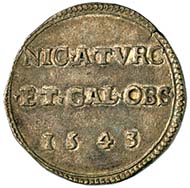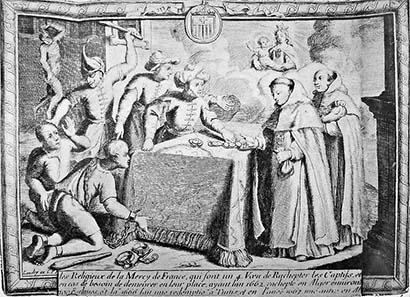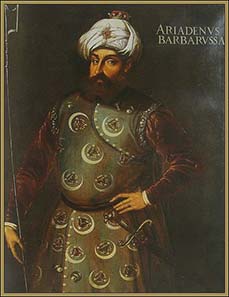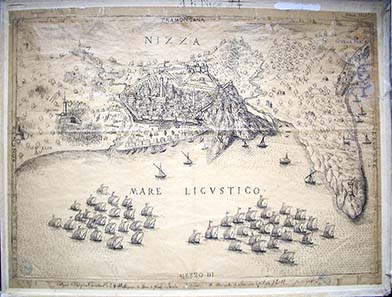The Siege of Nice in 1543
It is an unspectacular coin, that testimony of the culminating conflict between France and Spain, between Francis I and Charles V.
Emergency coin, issued on the occasion of the Siege of Nice in 1543.
It is made of poor silver, a simple coin, without any figural depiction. Only the legend refers to the most important facts: NIC A TVRC ET GAL OBS 1543, meaning Nice besieged by the Turks and the Frenchmen in 1543 as well as KROLVS II D SABAVDI, Charles III (on the coin erroneously referred to as II), Duke of Savoy. The named Charles was ruler of Nice and a close ally of Charles V. As said before, it is an unspectacular coin which nevertheless marks a historic moment of great importance: the moment when the rulers of Christianity were so at loggerheads that one of them, Francis I, did not resolve to his equals when he searched for allies but, without any religious scruples, formed an alliance with the Ottomans.
Trade in captives. 17th century. Source: Wikipedia.
After the crusades the so-called Barbary pirates had lodges themselves on the coasts of North Africa, outlaws who earned their living with pirating the ships that ferried armed und unarmed pilgrims over to the Holy Land. They were a nuisance but did not really pose a threat since they only approached unarmed ships without escort. That changed when the Ottoman sultan at the end of the 15th century began to utilize them: several adventurers operated officially on his behalf but independently in regard to the organization and hence originated the Turks fighting at sea in Europe.
Barbarossa Hayreddin Pasha. Painting from the 16th century. Louvre. Source: Wikiepdia.
One of the most famous Barbary pirates was to become Hayreddin whom the West nicknamed Barbarossa, Redbeard. Together with his brother he had taken Algiers in 1516 and had established a huge fleet there. To secure his position, he let himself nominally become subject to the Ottoman sultan. The latter saw in the audacious daredevil a perfect tool, bestowed upon him the title of Kaptan Pasha (= Admiral of the Fleet) and Beylerbeylik of Algiers, provided him with some war ships and Janissaries in the hope that this pirate would cause the House of Habsburg and its fleet big trouble.
To the House of Habsburg, Hayreddin indeed became a problem. Algiers was so favourably situated that the Redbeard blocked the Spanish the sea connection to Italy. The situation became unbearable so that Charles ceremoniously “crusaded” to Tunis in 1536. Tunis fell, but Charles did not bother about Algiers. He preferred to be celebrated in Italy only to realize some years later than the Barbary pirates had become the greater a nuisance than ever. Another push in 1541, this time directed towards Algiers, failed; 150 Imperial ships were destroyed in a storm. The Ottoman supremacy in the Mediterranean Sea seemed unbreakable.
Francis I of France of course was aware of that. He had benefited from the Ottomans tying up the Imperial forces on the East frontier of the Habsburg Empire. To make the enemies of one’s enemy a friend was per se a logical idea; the ease with which Francis I slurred over any distinction of creed, however, reminds of the already in the Renaissance nascent concept of recklessly applying any instrument of power possible. Machiavelli had published his Principe in 1532. Francis I, therefore, entered a contract with the admiral of the pirates granting his ships and merchants free trade in the waters controlled by Hayreddin. Subsequently, in 1541, shortly after the Spanish disaster, the pirates were won over to a joint operation.
Starting on the island of Corfu, Hayreddin sailed to the West coast of Italy. One of the myths and tales surrounding that passage is too nice to be omitted here: in Reggio / Calabria the fortress’ commander is said to have so panicked that he stroke the flag and saluted which Hayreddin’s fleet answered by volleying. The defensive works of Reggio, having no intention to enter the battle in the first place, lay in ruins; the pirate moved into the city and fell in love with the 18 year-old daughter of the overzealous salute giver. He married her on the spot and spared the lives of all citizens of Reggio as a morning gift for his wife.
The Siege of Nice by the Ottoman and the French fleet in 1543. Source: Wikipedia.
But let us return to the facts. From Reggio the fleet sailed up north to Marseille where Hayreddin united his forces with 50 French ships under the command of the Duke of Enghien to seize Nice which was governed by the Spanish. It was under the control of Charles III of Savoy, an ally of Charles V, whose representative Andrée de Montfort was intent on holding Nice. In June 1543, the united fleets of the Turks and the French cordoned off the fortress. The shelling began by land and by sea. Already on August 23rd, the invaders managed to get into the city whereas the hard core defenders retreat to the citadel.
The crew hold the citadel until, on September 9th, relief troops arrived unter the command of the Duke of Savoy and a Spanish ally, the Marquis de Vasto, Governor of Milan, prompting the besieger to retreat. If we are inclined to give credit to one of the numerous legends, however, it was completely different: Hayreddin, to his great displeasure, noticed the drinking parties of the French commanders. Being a Muslim, he was forbidden to drink wine and to eat the ham that was served in great quantities at these bouts. But only when the French ran dry of powder and asked Hayreddin for help, he voiced his criticism: he pointed at the heap of wine barrels that were scattered to the entire camp and asked if they were inclined to shoot with that wet powder for a change.
Hence, the good understanding between the French and the Barbary pirates were not so good after all after the seizure had failed. And when the pirates turned the city of Toulon, which was left to them as winter quarters after the inhabitants had cleared it, into a “real Constantinople”, Francis I refused to militarily co-operate any further with the pirates of Algiers. The Barbary pirates were to get the better of the Mediterranean Sea for almost an entire generation; that only changed in 1571, when the fleet of the Holy League under Don John of Austria wiped out the Ottoman fleet.
See the related article: The Battle of Lepanto










